Help is on the way

The vehicle's white cab is almost dwarfed by its rough-tread tyres, which reach up to shoulder height. Loaded with food or medicines, the allterrain vehicle rolls through thickets and over unpaved terrain – without anyone at the wheel. Being navigated remotely, it has nearly reached ist target – people in need, cut off from the outside world and urgently requiring supplies. The semi-autonomous SHERP truck has detected the stranded individuals on the far side of a large lake using its external cameras. Situation check: In the remote-control centre, an operator monitors the situation on screen. The operator steers the vehicle to the steep embankment and down into the lake. The wheels stop, and for a moment, the burly off-roader bobs up and down on the surface. Suddenly, water churns like in the wake of a Mississippi steamboat – and the aid transporter begins to propel itself forward.
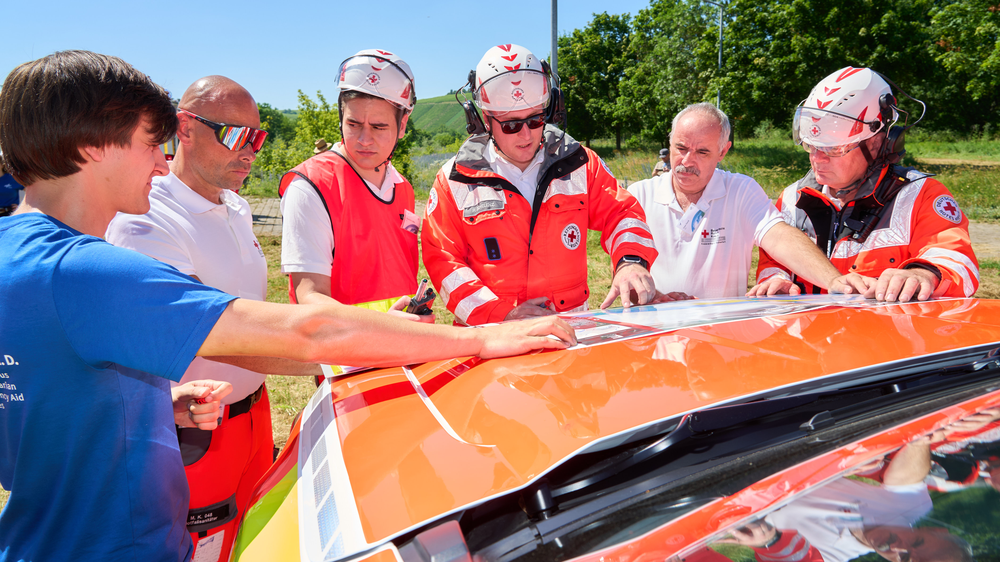
We are at the Bundeswehr training area in Nordheim am Main, attending the AHEAD (Autonomous Humanitarian Emergency Aid Devices) project demonstration. Armin Wedler from the DLR Institute of Robotics and Mechatronics is coordinating various units involving a total of 70 participants. Technical components and workflows need to be seamlessly integrated, ultimately intended for use in humanitarian aid and disaster relief. In the AHEAD project, DLR is collaborating with science and industry to develop solutions for driverless transport vehicles that can be remotely controlled to access hard-to-reach areas. The aim is to support emergency services where conventional vehicles cannot pass or would pose a serious risk to the responders' lives. "Our technologies are designed to enable humanitarian aid and rescue workers to operate safely on site. With this live demonstration, we are testing how effective and practical our developments over the last four and a half years have been," explains Wedler.
Many humanitarian missions take place in extreme situations. Projects like AHEAD are instrumental in ensuring that humanitarian aid can be delivered safely and efficiently to even the most remote areas
The demonstration is being conducted in collaboration with the United Nations World Food Programme (WFP) and the Bavarian Red Cross (BRK). It is June 2024, and the teams are running through two typical application scenarios: First, a humanitarian aid mission to deliver food that passes through rough terrain, dense and flooded areas. The specifications for this scenario are based on the work of the WFP in South Sudan, where efforts are ongoing to prevent acute hunger among approximately 8.3 million people. The second test scenario simulates a rescue operation in which an injured person is trapped by floodwater and is in urgent need of medical attention. In this scenario, the BRK is drawing on its experiences from the 2021 Ahr Valley flood and the floods that occurred in southern Germany in the summer of 2024, which resulted in several fatalities.

Steer clear of danger zones and get out
During the test deployment in the height of summer, beads of sweat drip steadily. Despite the heat, maximum concentration is required. This is part of the reality check when taking people and machines out of the lab and into the field. In future target areas like South Sudan, the average temperature is approximately 35 degrees Celsius. During the rainy season, this drought-stricken country is frequently hit by landslides and widespread flooding. Roads become impassable, complicating relief efforts even further.
Bernhard Kowatsch, Head of the Innovation Accelerator at the WFP, says: "Many humanitarian missions take place in extreme situations. Projects like AHEAD are instrumental in ensuring that humanitarian aid can be delivered safely and efficiently to even the most remote areas. Working with DLR brings us closer to providing assistance to those who need it the most, even under such extreme conditions."
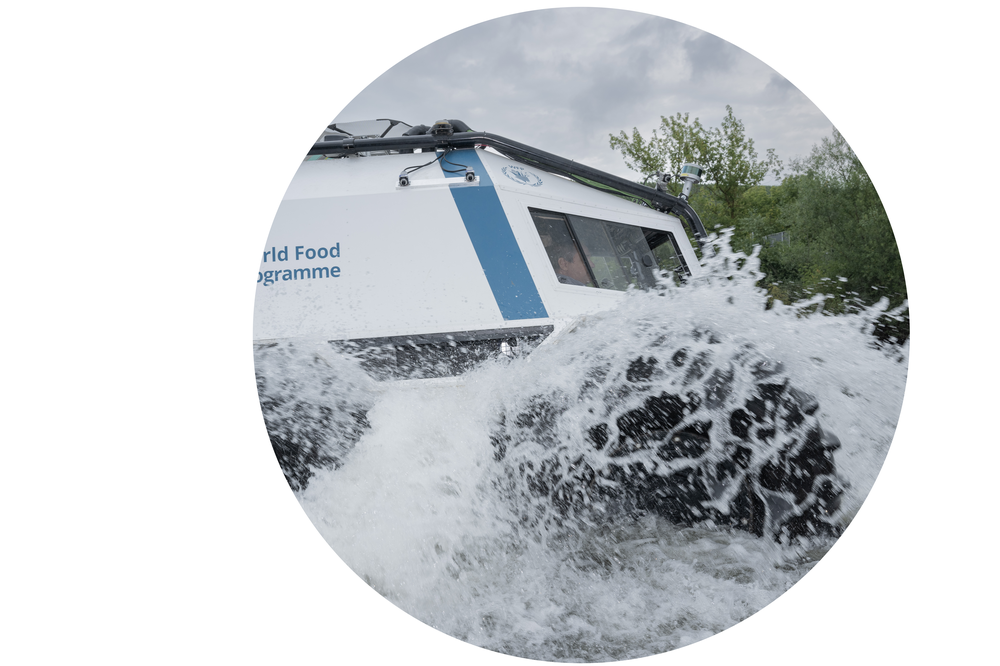
The upgraded AHEAD transporter, an amphibious SHERP vehicle developed in Ukraine in 2012, is unfazed by the conditions in Nordheim. The WFP utilises SHERPs for the 'last mile' – the critical final five to 50 kilometres to the target destination. However, these are still conventionally driven by a person inside the vehicle. This is set to change in the near future, given the serious dangers that can be encountered along the way: disease-transmitting insects, epidemics, landmines and armed attacks. In this area of Germany, relief services also frequently find themselves in hazardous situations. During floods, sudden landslides can occur and strong currents may even capsize rescue boats. A semi-autonomous SHERP would enable responders to operate safely at the scene and, in the future, could also be used to retrieve people from danger zones. It can accommodate up to eight people.
For the AHEAD stress test, the BRK has mobilised more than 20 members of the G.I.L.T. (terrain, infrastructure, logistics, transport) rapid response group, along with other water and mountain Rescue units. "AHEAD helps us to better cope with the increasing number of natural disasters. Automated driving does not pose a risk to drivers, and we can reach crisis areas that are impassable due to washed-out roads or destroyed bridges. In addition, the technology on board the special-purpose vehicle enables us to quickly create a digital picture of the situation and carry out search and rescue operations in an even more targeted manner than before," says Uwe Kippnich, Coordinator of Research on safety measures at the Bavarian Red Cross.
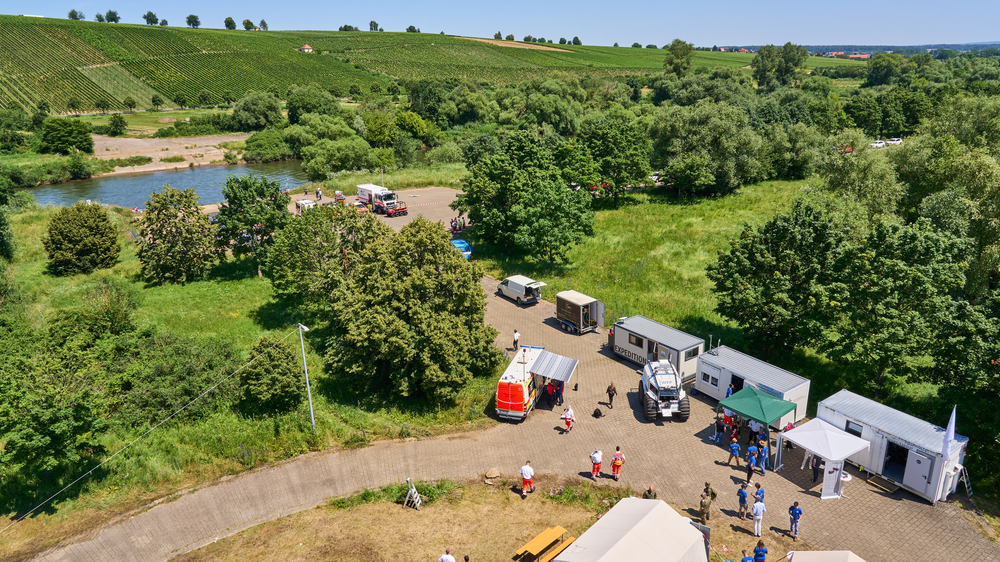
Success in the water, preparation on land
The emergency scenarios may be simulated, but the tension on the ground of the military training area is palpable. For the first time, the AHEAD team can test whether their vehicle also stays afloat when operated remotely. Dozens of eyes light up the moment the balloon tyres begin to plough through the water and follow the prescribed route. It is still too early for cheers, but the researchers know that an important hurdle on the road to operational maturity for their technologies has been cleared.
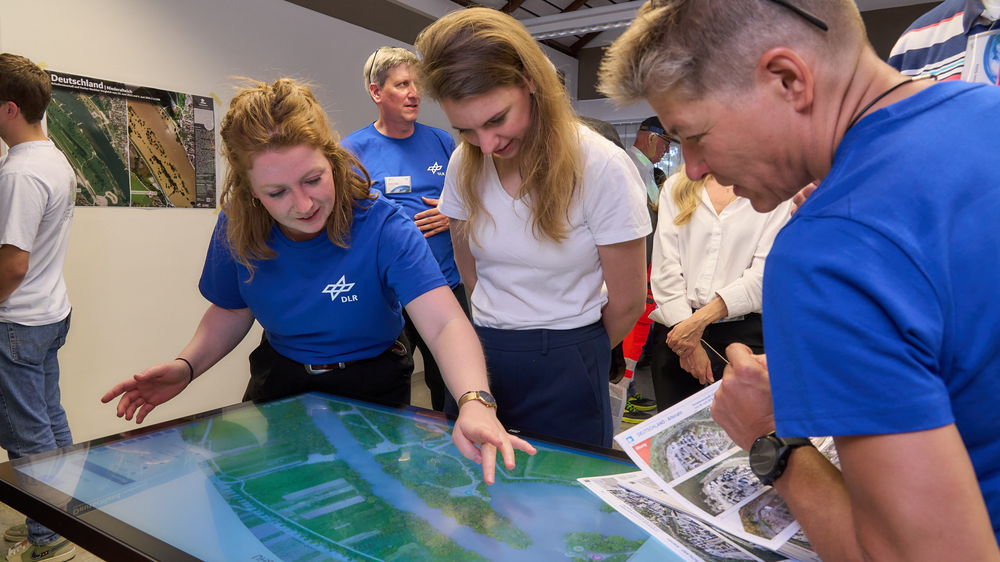
Multiple organisational units are collaborating to ensure that the SHERP can perform its tasks autonomously. "We have a control centre for the overall mission, another for the teleoperated vehicle and a communications unit that facilitates data exchange," explains Armin Wedler, as he leaves the observation point on the lakeshore and heads towards the barracks, which are about one kilometre away. This is where colleagues from the Center for Satellite Based Crisis Information (ZKI) at the DLR Earth Observation Center have established their base. They are providing the global mission control centre (GMOC) for this project.
The GMOC is tasked with planning and monitoring the remote truck mission. The control centre collects and evaluates remote sensing data, such as high-resolution satellite images, aerial photographs and drone images, to characterise the environment and determine the optimum route. The results are sent in various formats directly to the emergency services on the ground: as situation maps, in the form of conventional printed maps to be used in the field and through data fed to an interactive web application. In future operations, the GMOC will be a fixed centre that can support operations around the world. For the test runs, the team set up its headquarters well away from other units, with no view of the action.
Sensitive yet robust remote control
The local mission control centre (LMOC) is positioned at the last safe deployment site, housed within a mobile container nearly seven metres in length. It is connected to the GMOC and commands the aid transporter. The remote control is operated primarily through automation along a pre-planned route, with the vehicle continuously transmitting its position and 360-degree environmental data to the LMOC. To facilitate this, the vehicle is equipped with a radio antenna, perception sensors, depth cameras and a lidar system, akin to those used on lunar or Martian rovers. Technological support is provided by the DLR spin-off Roboception. There is also a landing pad on the vehicle's roof for drones that can gather supplementary information. The team in the command centre monitors all activities live on a screen.
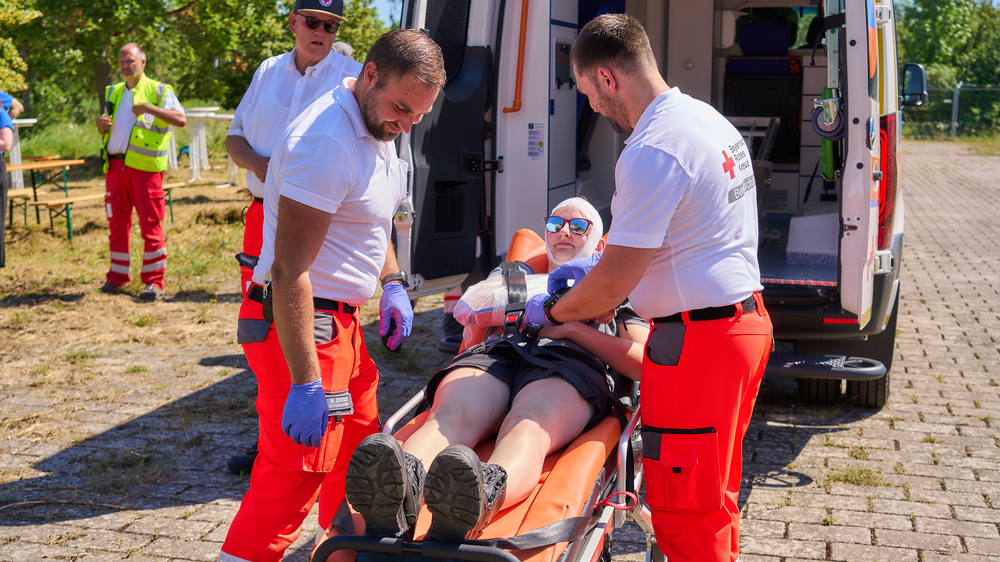
If necessary, a member of staff, the 'teleoperator', intervenes. The teleoperator sits in an input station equipped with levers for steering and gear changes, switches for functions like lights and horns, and foot pedals for braking and clutching. What sets the LMOC apart is that the operator can feel how the vehicle behaves on the terrain thanks to a 'force feedback' mechanism. The secret lies in the torque-controlled motors – when the truck rambles through the wild greenery of the test site, the remote operator feels any roughness through the mechanical resistance in the control levers. This sensitive telerobotics technology originates from the space industry and is being further developed for humanitarian aid and crisis response on Earth, in collaboration with the DLR spin-off Sensodrive as part of the AHEAD project.
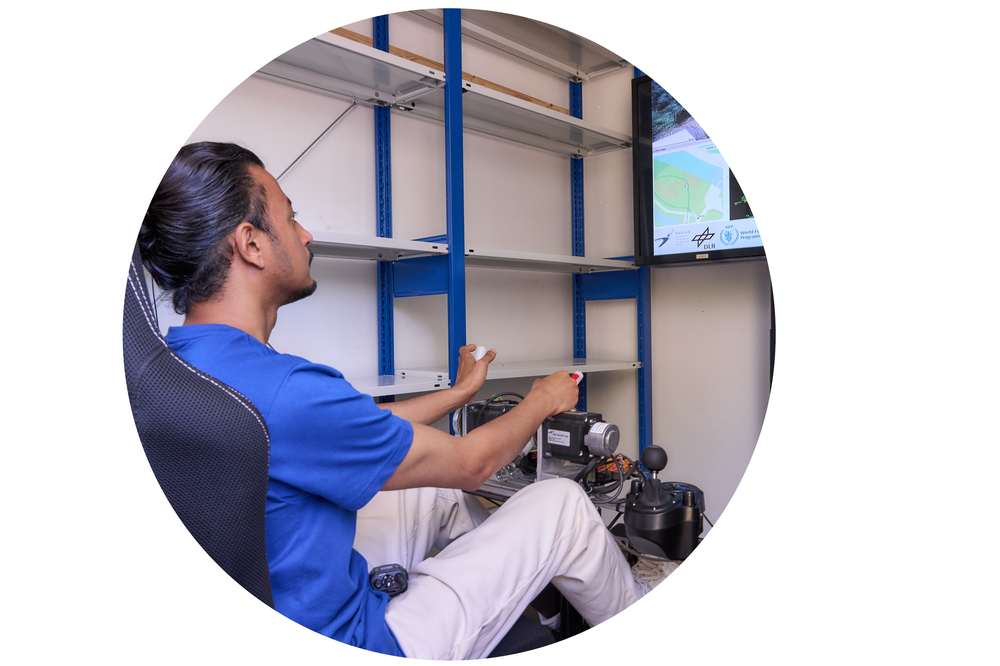
If the connection between the SHERP and its operator is lost, the vehicle stops automatically – a critical safety feature of the semi-autonomous remote-controlled vehicle. To prevent such disconnections and ensure a steady data flow between all units, the aid transporter and the two control centres are linked through multiple systems, including mobile communications, satellite communications and broadband internet. Furthermore, LMOC and the vehicle are connected via a local radio network. The DLR Institute of Communications and Navigation is contributing its expertise here. In the scenarios involving the World Food Programme and the Bavarian Red Cross, researchers assessed areas where communication quality is sufficient for route planning. They are also developing a simple predictive model for radio connectivity in the operational area. The researchers ensure that the radio connection to the vehicle is robust and remains uninterrupted during the live demonstration.
Technology transfer for relief transport
Two DLR spin-offs – Sensodrive and Roboception – are collaborating with their parent institute, the Institute of Robotics and Mechatronics in Oberpfaffenhofen, on this project. They have now firmly established themselves in the fields of telerobotics and perception. Alongside their technical expertise, they bring invaluable experience in successfully transferring innovation from research to industry. Armin Wedler and his team are striving to make their technologies and concepts available to the WFP, the Bavarian Red Cross and many other stakeholders as quickly as possible. Once their feasibility has been proven, the focus will shift to fine-tuning – enhancing capabilities and increasing efficiency.
Meanwhile, the transporter has reached the other shore. It accelerates out of the lake and climbs the final few metres to reach the people in need of assistance. They open the boot of the dripping vehicle, and sacks of basic foodstuffs are unloaded. In the flood scenario, one person is injured. Rescue workers make their way to the scene across the water. They attend to the young woman, carry her to the SHERP and climb in with her. The control centres then give the green light for the return journey. With its new 'cargo', the rescue vehicle traverses water and undergrowth, safely returning to its starting point. Mission accomplished; feasibility demonstrated. AHEAD is ready to take its next steps.
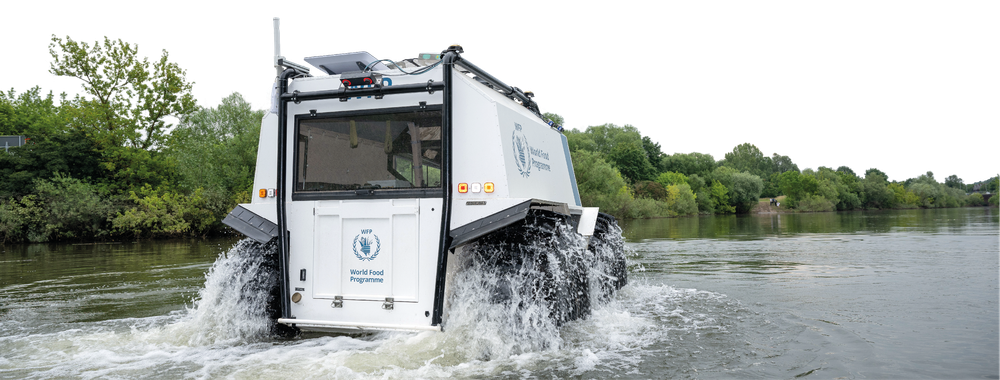
The AHEAD project
The AHEAD project is led by the DLR Institute of Robotics and Mechatronics, in cooperation with the DLR Institute of Communications and Navigation, Center for Satellite Based Crisis Information (ZKI) at the DLR Earth Observation Center, DLR Institute of Transportation Systems, the United Nations World Food Programme (WFP) Innovation Accelerator, Roboception GmbH, Sensodrive GmbH, Blickfeld GmbH and the project management agency VDI/VDE Innovation + Technik GmbH (VDI/VDE-IT).
The AHEAD collaborations – KI4HE, MaiSHU, MUSERO, iFOODis and RESITEK – are also integral to AHEAD, with funding provided by the Bavarian State Ministry of Economic Affairs, Regional Development and Energy.
An article by Bernadette Jung from the DLRmagazine 176
Related links
- DLR - Institute of Robotics and Mechatronics
- DLR - Institute of Communications and Navigation
- Center for Satellite Based Crisis Information (ZKI) at DLR
- DLR - Institute of Transportation Systems
- Featured topic – Aerospace technologies for humanitarian aid
- WFP Innovation Accelerator of the UN World Food Programme (WFP)
- Roboception GmbH
- Sensodrive GmbH
- Blickfeld GmbH
- VDI/VDE Innovation + Technik GmbH
